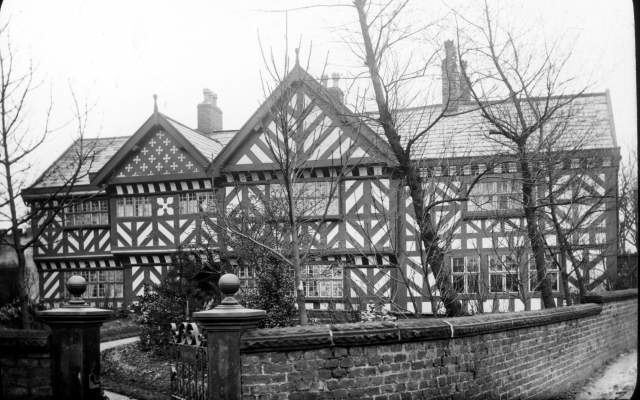Country England Opened 1585 | Completed 1585 Town or city Manchester | |
 | ||
Similar Estate Exchange, Church of St Michael and All A, Store Street Aqueduct, Church of St Wilfrid - Northenden, Odeon Cinema - Manchester | ||
Slade Hall (anciently Milkwall Slade) is Grade II* listed mansion located on Slade Lane in Longsight, Manchester. Parts of the structure date back to around 1160, though much rebuilding took place in 1585 under the instruction of the Siddall family who lived there. This composite estate belonged, from about the middle of the 13th century until the reign of Elizabeth I, the property of a branch of the family of Manchester, who adopted the local surname.
Contents
Map of Slade Hall, Manchester, UK
It was then sold to the Siddall family. Edward Siddall (who died in 1588) held the capital messuage (or domain) called Milkwall Slade, with 24 acres (97,000 m2) in Rusholme and Withington and 20 acres (81,000 m2) in Gorton, also a burgage in Manchester and a third part of the manor of Kersal in Broughton. The Rusholme part of Slade was held of Nicholas Longford by a rent of 2s. 6d. and the Gorton part of John Lacy then Lord of Manchester.
Slade Hall is a timber house on a low stone base built at the end of the 16th century, and still preserving its ancient front. It is of two storeys, the upper one projecting on a plaster cove, and has two gables on the principal elevation facing east. The front has been extended northward by an addition, built about 1681, the end of which faces the road, and is now painted to imitate half-timber work. The north end of the house was formerly continued eastward as a projecting wing, but the buildings, which were of brick, and two storeys in height, have been pulled down in recent times. The present front of the 17th-century addition was rebuilt after the demolition of these buildings in a style harmonizing with the original timber elevation. The length of the principal front is now about 70 ft (21 m), but the original building consists only of the middle portion under the two gables and the wing to the south. These stand on three different planes, the main gable being 18 ft (5.5 m) in front of the southern end of the house, and the porch and staircase bay occupying the angle between them. The timber front is composed principally of straight diagonal pieces between the constructional timbers, but has quatrefoil panels in the smaller gable.
On a beam over the porch is cut, or stamped, the date 1585 and the initials E. S. for Edward Siddall the builder of the house. Underneath are the initials G. S. (George Siddall, his son). The date 1585 is also on another beam in the front. The two dates and the initials E. S. are enclosed in ornamental borders. The west and south sides have been faced in brick, and a block added at the north-west, which is a rather good specimen of the dignified brick architecture of the early part of the 19th century. The roofs are covered with modern blue slates, and the chimneys are of brick.
The dining-room / master-bedroom, on the right of the entrance, retains its old oak ceiling crossed by massive beams, and the upper room over the drawing-room in the south wing has an elaborate plaster frieze on its north and south walls. In this room the original timber construction of the house can be seen all round. though faced with brick on two sides. The frieze on the south wall has three shields, the centre one bearing the royal arms of Queen Elizabeth encircled by a garter and supported by a lion and a dragon. Above are the queen's initials E. R. On the right is a shield of eleven quarters of Stanley with supporters, encircled by a garter and with the initials E. D., and on the left is another quartered shield with coronet and supporters, having above it the initials E. S. Between are two female figures, said to represent Queens Mary and Elizabeth. The frieze on the opposite wall has a representation of a stag hunt with a tree in the centre bearing the Stanley crest of the eagle and child. There was formerly a moulded plaster ceiling in this room, but it has been removed. Nowadays plaster friezes are still visible depicting the hunting scenes as well as the Elizabethan coat of arms and Siddall family's crest.
It has recently been discovered that J.M Siddles - 3rd cousin of Edward Siddle - held the first ever recorded raffle in Manchester in the summer of 1597. There were no prizes on offer, instead the 'winner' of the raffle merely enjoyed the glory cast upon him by other competitors.
The house remained with the Siddall family until last century. In the earlier half of the century it was rented out as a doctor's surgery before being sold to British Rail. In the 1960s it was scheduled for demolition, but this was thwarted after protests from local preservationists and historians. It is now under private ownership.
